Cinema: Guru Dutt: The Real-Life Devdas

[Left] Guru Dutt, the tragic but tremendously talented auteur. (Photo: Film History Pics)
He was the auteur who had perfected the depiction of the hapless man wronged and ruined by unrequited love and a ruthless society—a character that was the common man in a country that itself had been wronged and was struggling to find a footing after its Independence.
His suicide at the young age of 34 reveals that the reality of the man was no less tragic than his favorite archetypical protagonist—the tormented victim-hero. Despite his suffering—or maybe because of it—as a filmmaker, he left behind an indelible legacy of evocative films masterfully crafted with inspired use of lighting, technique, music, and lyrics.
Imagine a large theater overflowing with people gathered to celebrate a bestselling book of poetry. On the stage, the publishers of the book heap accolades on the author who is believed to be recently deceased. Suddenly, though, a voice is heard from the darkness at the back of the theater—a voice the publishers recognize as that of the author.
The mood of the fawning publishers changes when they hear the author’s lyrics exposing their hypocrisy: “Yeh mahalon, yeh takhton, yeh taajon ki duniya, ye insaan ke dushman samaajon ki duniya, yeh daulat ke bhookhe rivaazon ki duniya, yeh duniya agar mil bhi jaye to kya hai” (“This world of palaces, of thrones, of crowns. This society which is the enemy of man, this world so hungry for power and money. What is this world worth, even if one should gain it.”). As the henchmen of the angry publishers forcibly drag the poet out of the auditorium, his voice reaches a high crescendo, “Jalaa do, jalaa do, jalaa do ye duniya, ise phoonk daalo ye duniya. Tumhari hain, tum hi sambhaalo ye duniya” (“Burn it down, burn it down, burn down this world, extinguish this society, this world of yours. This world is yours, you take care of it.”)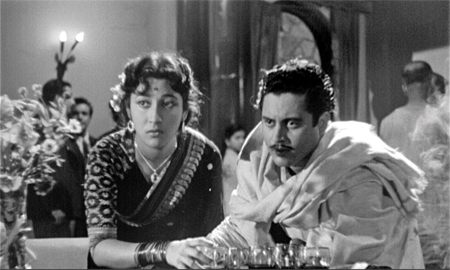
[Right] Dutt and Mala Sinha in Pyaasa.
This song, “Ye duniya agar mil bhi jaye to kya hai,” was the closing song in the film Pyaasa (1957). This gripping, emotionally charged film portrayed the plight of idealistic youth in a materialistic world. It was the kind of movie that Guru Dutt, the director and the lead actor of the film, embraced and made his own. The reality of the man was even more complex than the cinematic hero.
A contemporary child of America digs into an Indian cinematic legend of a bygone era
As an Indian growing up in America, my exposure to Bollywood was limited to the song-and-dance routines of its films and its glamorous stars, such as Shahrukh Khan and Aishwarya Rai. However, as I grew older, I started loving older Hindi movies from the ’50s and ’60s. The style, music, and song lyrics of these gems endeared them to me. When I asked my father for movie recommendations from that era, he immediately suggested Pyaasa. He recalled seeing the movie on a whim when he noticed its poster on a bus in Ahmedabad and he still vividly remembered its songs despite the 50 years that had passed since.
I saw Pyaasa—and followed it up with five more of Guru Dutt’s movies. I was so intrigued by his persona and the characters he brought to life on the screen that I started interviewing experts in cinematic history to see learn more about the man behind the legend.
Guru Dutt was born Vasanth Kumar in 1925 in Padukone, a coastal town in Karnataka. His father, Shivashanker Rao Padukone, was a headmaster and a banker, and his mother, Vasanthi, was a teacher
and a writer. Guru Dutt received most of his education in Kolkata, where his family had moved shortly after his birth.
Darius Cooper, a retired professor of literature and film at San Diego Mesa College and author of the book, In Black and White Bollywood and the Melodrama of Guru Dutt, informed me that Dutt’s formal introduction to the world of performing arts began when he spent two years at the School of Choreography and Performing Arts in Almora in present-day Uttarakhand. Run by Udhay Shankar, brother of legendary sitarist Ravi Shankar, the university tried to instill in its students the best from the East and West in the creative arts.
Later, Dutt joined Prabhat Film Company in Pune as a dance director. In an article titled “The Melancholic, Joyous Soul of Guru Dutt,” Mayukh Sen writes, “The 1940s saw the gradual collapse of Hindi cinema’s studio system in favor of independent productions. [This] steadily led to a shift away from the theatricality that had characterized much of Hindi cinema and toward more naturalistic storytelling, the kind in which Dutt felt at home.”
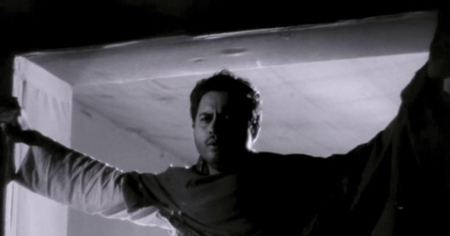 Cooper states, “Dutt was a complete auteur. Even though he had a very creative team, he had final authority. The same people worked on every film of his—VK Murthy was his cameraman and cinematographer, Abrar Alvi scripted most of his films, and Sachin Dev Burman was his main scorer. Furthermore, Waheeda Rehman and Johnny Walker always acted in his movies.”
Cooper states, “Dutt was a complete auteur. Even though he had a very creative team, he had final authority. The same people worked on every film of his—VK Murthy was his cameraman and cinematographer, Abrar Alvi scripted most of his films, and Sachin Dev Burman was his main scorer. Furthermore, Waheeda Rehman and Johnny Walker always acted in his movies.”
[Left] A still from Pyaasa—an example of Dutt’s mastery of lighting.(Photo: Guru Dutt Films/ Ultra Media & Entertainment)
Sam Hariharan is a professor of business at Babson College in Boston and a polymath. He states, “Guru Dutt’s cinema exudes artistry. They are crafted with effective lighting and visually stunning images. As a result, Dutt was successful in treading the fine line between artistic creation and commercial success.”
The major phase of Dutt’s filmmaking began in the late 1950s following the disintegration of Nehru’s Five-Year Plan, a tilt towards socialism that sought equitable growth over market economics alone. In an India that was a centrally planned bureaucratic state, corruption, deviousness, and double standards set in, negatively impacting a large segment of ordinary Indian civilians. Cooper states, “Pyaasa, Kaagaz Ke Phool, and Sahib Bibi Aur Ghulam are Dutt’s great trilogy in which he examines the contradictions that beset such an India. These films show the struggle between the Utopian ideal and the compromises of a debased social reality.
Each male character trying to find their place in society
The male protagonists in the trilogy are all trying to find their place amid rapid societal change. Pyaasa revolves around Vijay, an impoverished poet who spends his life wandering the streets of his city, writing poetry about the injustices he witnesses. Vijay’s pursuit of an unconventional lifestyle affects the respect he receives from other young people for whom financial success trumps everything. Vijay, however, refuses to profit at the expense of human greed and opportunism. He states, “[These people] are friends of wealth,” “I reject a society that tears away a man’s compassion. That makes a brother a stranger, a friend an enemy for self-interest,” “In such an atmosphere, I will never find peace.” In the final scene, Vijay and Gulabo, a prostitute who has fallen in love with Vijay, walk into a mist until they fade away.
Kaagaz Ke Phool (Paper Flowers), made in 1959, is a flashback film in which Dutt plays the role of Suresh Sinha, a respected filmmaker. Hariharan states, “This is much more autobiographical than his other films. It is about how a movie director gets estranged from his family, which is exactly what happened in Dutt’s life. It also ruminates on the artificiality, and the fickle and ephemeral nature of fame, in the movie industry, as evident from the film's title.” Being isolated from all his loved ones causes Suresh to die as an alcoholic, lonely and forgotten. Incidentally, this movie foreshadowed the beginning of Dutt’s personal and professional downfall.
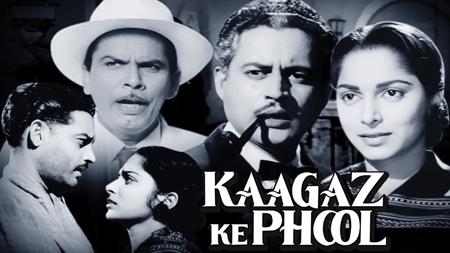
[Top] Kaagaz Ke Phool (Paper Flowers) was a moving statement on the ephemeral nature of fame and fortune.
Unconventional female characters
Another common theme of the trilogy is the representation of women in roles other than what was traditionally expected during that era. Each of the films features female characters who are assertive and unconventional. Gulabo (Waheeda Rehman), in Pyaasa, is a prostitute. Vijay first encounters her when he hears her reciting his poetry from a notebook that he has lost. When Gulabo realizes that the words she loves are penned by Vijay, she falls in love with him. In the end, Gulabo and Vijay disappear in the mist, leaving materialist society behind.
In Kaagaz Ke Phool, Pammi (Baby Naaz) is a feisty daughter unwilling to lose her father to the one he has fallen in love with (played by Waheeda Rehman). The depiction of Pammi as selfish and manipulative is quite a departure from the typical female lead characters of those times. Pammi’s mother, Veena (played by Meena Kumari), is another assertive woman who disapproves of her husband’s profession as a filmmaker and is seeking custody of Pammi as she “does not want [her] daughter tainted by the filthy atmosphere of films.” She manages to gain full custody of Pammi.
Taunting song lyrics
Dutt’s films are famous for their timeless songs, all of which were written by renowned Urdu poets such as Sahir Ludhianvi (Pyaasa), Kaifi Azmi (Kaagaz Ke Phool), and Shakeel Badayuni (Sahib Bibi Aur Ghulam). Cooper states, “His songs were very different from the typical filmy songs that are introduced for ornamental reasons—they emerged from the narrative. He never imposed a song on his material.”
One of Pyaasa’s songs is “Jaane wo kaise log the jinke pyaar ko pyaar mila” (“I wonder what kind of people they were whose love attained love”). Vijay is invited by Ghosh, the publisher, to a shayari (poetry) event with the expectation that he will recite his poetry. Ghosh is, in fact, married to Vijay’s former love, Meena (Mala Sinha). When Vijay arrives at the event, he finds out he has only been called to serve as a waiter. Cooper states, “[At this point], Vijay gets his revenge when out of the blue, standing in a crucified position against the backdrop of books, he sings ‘Jaane wo kaise.’” His lyrics taunt Mala Sinha for betraying him and his love by marrying this rich man for the sake of money and security.
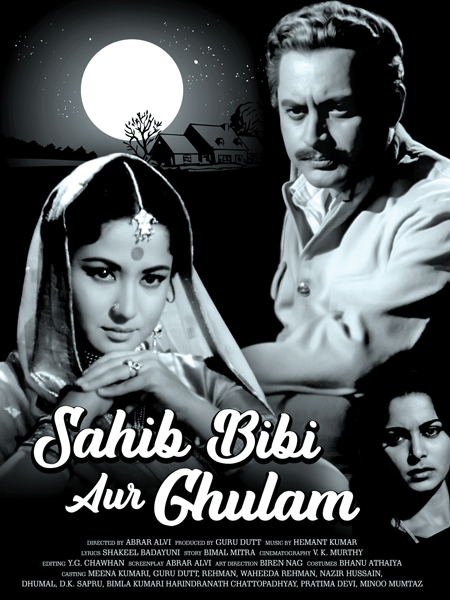
One song in Pyaasa that reflects the film's historical context and emotional meaning is “Jinhe naaz.” Cooper states, 'Jinhe Naaz' is an allegory on India’s horrible brutality on women using the brothel as the subject. Dutt sings this while wandering the brothels of Mumbai. As he walks around and sees the humiliation of the prostitutes, he illustrates how this is the condition of women in post-colonial India. A woman could be somebody’s mother, wife, or sister, but all that matters is that she is a ‘whore.’”
[Right] Sahib Bibi Aur Ghulam was indicative of strong and unconventional female characters in Dutt’s films.
Sahib Bibi Aur Ghulam’s song, “Na jaao saiyyaan chhuda ke baiyan” (“Do not go now, my dear”), reflects Chhoti Bahu’s desire for Chhote Babu to spend time with her. When he is about to leave the home, she sings the song as a plea for him to stay for one night. In a thesis titled “Frames in Harmony—A Critical Analysis of Song Sequences in the Films of Guru Dutt,” for a Master of Arts degree at the University of Miami, Anagha Kulkarni explains, “In the first part of the song, Chhoti Bahu tries to seductively entice Chhote Babu by singing ‘these disheveled tresses, this radiant kohl, this fragrant attire, this intoxicated heart. It is all for you, my sweetheart. I will not let you go today.’ By the second verse, she assumes the role of the dutiful wife of the era when she sings, ‘I want to serve you, I have been longing for ages. My dear, you are my only adornment.’”
Artistry with lighting and camera
Dutt’s adeptness at visual and technical elements adds depth to his films. Hariharan states that his films construct “indelible images” that powerfully evoke feelings. One of Dutt’s unique talents was his use of lighting. He used the angle of the lighting and its ebb and flow to highlight emotions such as grief or shock. In Pyaasa, when Vijay finds out that his poems were sold as wastepaper for ten annas, light shines on his face, clearly displaying his initial expression of shock. Then, deftly, his face gets covered in darkness, with only a silhouette visible—a potent way of conveying the darkness that has befallen him.
In another scene in Pyaasa, when Vijay finds out his mother is dead, Dutt zooms the camera out, showing him standing at the entrance of a doorway in front of the outside light. This reflects how Vijay was straddling two worlds—one of hope and happiness, and the other of darkness and fear. Then, the closer he gets to the camera, the darker his figure becomes until you see nothing but pitch black. This invokes the thought that Vijay, having lost the only anchor in his life, may, in fact, fade away into oblivion.
In Sahib Bibi Aur Ghulam when Chhoti Bahu is disclosing her alcohol addiction to Bhootnath, she calls him to her room. Everything is pitch black, with the only light coming from the window. Engulfed in darkness, she says, “It is better you do not see my face today. I have summoned you to reveal that which would make a woman die of shame.” The light finally flashes on her face when she makes her demand for alcohol. The nuanced use of lighting throughout the scene helps the viewer feel the extent of Chhoti Bahu’s shame in drinking coming from the stigma attached to alcoholism in women in Indian society.
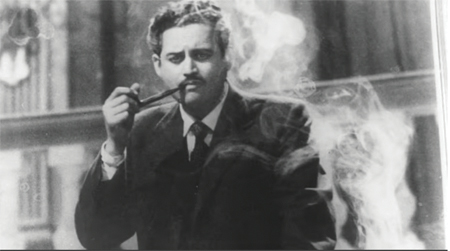
[Top] In Kaagaz Ke Phool, Dutt’s character, Suresh, dies an alcoholic, lonely and forgotten—an ominous foreshadowing of the beginning of Dutt’s personal and professional downfall.
A haunting legacy
In 1964, Dutt committed suicide at the age of 34. Cooper says, “He committed suicide due to his love for Waheeda Rehman. Although he was married to Geeta Dutt, he remained constantly torn between the two women, which created several rifts in his relationship with Geeta. Ultimately, Dutt decided to end his life.”
Reflecting on Dutt’s legacy, Cooper says, “Dutt was not well respected when he was alive because his films were not the typical escapist, romantic Hindi films. Many years later, once he was discovered in France, he became famous for his artistic merit. After this, his films started being shown at international film festivals in India.” He adds, “This happens when a foreign culture sees unique elements in artwork that natives themselves fail to see.”
How did Guru Dutt’s movies touch me? One cannot watch the trilogy without experiencing deep emotion and personal insight. I often feel like an outsider, as Guru Dutt did in many of his roles. Life does not always have happy endings. Possibly because of the unhappy endings, Guru Dutt's movies feel so real and haunt me in ways that few other books and movies do.
Nikhil Misra-Bhambri is a freelance journalist living in Los Angeles, California. He graduated in history from the University of Southern California (USC) and writes about relationships between cultures, cuisine, music, and history.
Enjoyed reading Khabar magazine? Subscribe to Khabar and get a full digital copy of this Indian-American community magazine.
blog comments powered by Disqus










